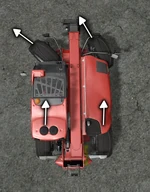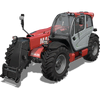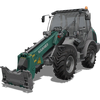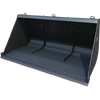A Telehandler is a type of Vehicle in Farming Simulator 17. More specifically, it is one of four different types of Loaders - vehicles designed for lifting, shoveling, and otherwise manipulating materials and cargo. Telehandlers have a unique telescopic arm that can extend beyond its original length, allowing the vehicle to lift cargo far off the ground, stacking Pallets or Bales and manipulating other objects far above the ground.
"Classic" Telehandlers are short and flat vehicles, with the hydraulic arm coming out from behind the driver's cabin. This configuration gives the vehicle good stability even when lifting heavy objects very high up. Classic Telehandlers use "All-Wheel Steering" to improve maneuverability, making them almost as nimble as Skid Steer Loaders despite their size. They can switch to "Front-Steering" and "Crab-Steering" as well, when needed.
The base game also offers two types of "hybrid" Telehandlers that sacrifice some of the length of the telescopic arm in favor of other advantages normally associated with other types of Loaders. One such model in the game is a Wheel Loader/Telehandler hybrid (has an articulated body), while the other is a Front Loader/Telehandler hybrid (capable of using tools designed for a Front Loading Arm).
Telehandlers have access to a reasonable variety of Tools for different jobs. However the main reason to buy a Telehandler at all is to work at heights unreachable by other Loaders, and this usually only involves lifting Pallets and Bales. Other types of Loaders are typically better at all other types of jobs.
List of Telehandlers[]
Farming Simulator 17 features four different models of Telehandlers by default. The following three Telehandlers can be found in the "Telehandlers" section of the store:
| Name | Price | Maintenance cost per day |
Horsepower | Max Speed (km/h) |
Fuel Capacity |
|---|---|---|---|---|---|
| Liebherr TL 436-7 | 92,000 | 170 | 122 | 40 | 120 |
| Manitou MLT 840 | 107,000 | 180 | 141 | 40 | 126 |
| JCB TM320S | 112,000 | 180 | 145 | 40 | 160 |
An additional unique hybrid model can be found in the "Front Loaders" section of the store. While technically similar to a Telehandler, it can only be fitted with Tools designed for Front Loaders (found in the same section of the store).
| Name | Price | Maintenance cost per day |
Horsepower | Max Speed (km/h) |
Fuel Capacity |
|---|---|---|---|---|---|
| Kramer KL30.8T | 60,000 | 130 | 75 | 40 | 85 |
Telehandler Tools[]
Farming Simulator 17 offers six different Loading Tools for Telehandlers. These can all be found in the "Telehandlers" category at the store. Telehandler Tools will only attach to a Telehandler's arm - they cannot be fitted to any other vehicle in the base game.
Common Features: $5 Maintenance Cost per Day
| Name | Price | Tool Type | Capacity | Weight |
|---|---|---|---|---|
| Magsi Shovel | 2,800 | Bucket | 4,500 | 597 |
| Magsi Telehandler Pallet Fork | 1,200 | Pallet Fork | -- | 173 |
| Magsi Bale Fork | 1,100 | Bale Fork | -- | 168 |
| Magsi Wrapped Bale Handler | 3,300 | Bale Handler | -- | 297 |
| Magsi Manure Fork | 2,900 | Manure Fork | 3,500 | 485 |
| Magsi Telehandler Log Fork | 3,400 | Log Fork | -- | 495 |
Steering Options[]
Most Telehandlers have the ability to switch between three different types of steering options, which affect the way the Telehandler's wheels turn. Each steering method gives very different results from the others, and is used in different situations.
All-Wheel Steering[]

All-Wheel Steering.
This is the default steering option for Telehandlers. With this option active, all four of the Telehandler's wheels will participate in steering the vehicle. When you turn the steering wheel in any direction, the front wheels of the Telehandler will turn in that direction, while the rear wheels turn in the opposite direction.
As a result, the Telehandler will have a very small turning radius for its size. It cannot turn quite as sharply as a Skid Steer Loader, but for its size the Telehandler becomes very maneuverable with this option selected.
All-Wheel Steering is best when the Telehandler is lifting materials and cargo.
Front-Wheel Steering[]

Front-Wheel Steering.
The Front-Wheel Steering option causes the Telehandler to steer like a car (and like most other vehicles in the game), turning its front wheels in the direction you want to go. The rear wheels do not rotate - they face forwards at all times.
Front-Wheel Steering increases the turning radius of the Telehandler to what would be expected of a vehicle of its size. However the vehicle becomes much easier to steer when traveling at speed.
Front-Wheel Steering is best when the Telehandler is driving from place to place (e.g. on roads).
Crab Steering[]

Crab Steering (Left).
With the Crab Steering option activated, all four wheels of the Telehandler will rotate slightly in one direction (either left or right, depending on which Crab Steering Option you choose), and will remain in that orientation as long as you don't touch the steering wheel. If you drive forward or backward, the vehicle will move in a diagonal line in the chosen direction.
This allows the Telehandler to "shift" to the left or to the right without changing its orientation. This is great when loading Pallets, which require precise orientation to lift.
Note that in Crab Steering mode, touching the steering wheel will cause the wheels to rotate as though the vehicle was in "All-Wheel Steering" mode (see above). Crab Steering only matters when driving forwards and backwards without touching the steering wheel.
Comparison with other Loaders[]
Telehandlers are one of four different types of Loaders. Below is a list of advantages and disadvantages of Telehandlers over the other three categories.
Note: This articles only compares the "True" Telehandlers to other Loaders. The game offers several "Hybrid" Telehandlers as well (listed above) which trade some of the advantages of Telehandlers for the advantages of other Loaders.
Advantages[]
- Long Reach: The primary advantage of True Telehandlers is their incredibly long hydraulic arm. It can be extended to an impressive height - more than twice higher than any other type of Loader. This allows Telehandlers to create and dismantle very tall stacks of Pallets and Bales.
- Stable: True Telehandlers are flat and wide, and their center of weight is placed in such a way that makes them difficult to flip over even with their huge hydraulic arm extended very far above the vehicle. This helps them maintain stability despite manipulating heavy objects at great height off the ground.
- Excellent Steering: Although not quite as nimble as Skid Steer Loaders, the steering mechanism of True Telehandlers gives them a very small turning radius and fine controls. Telehandlers can also switch between four different types of steering options (see above) for different situations.
- Large Tools: Most Telehandler tools are either larger or more effective than Front Loader or Skid Steer Loader tools.
- Good Tool Variety: Telehandlers have access to almost all different types of Loading Tools. They can therefore perform nearly any kind of lifting job.
Disadvantages[]
- Jack of All Trades: While Telehandlers can handle all sorts of different jobs, they are not necessarily best at any of them. Skid Steer Loaders typically have an advantage in small, precise jobs; Wheel Loaders have an advantage in size and weight for heavy-duty jobs; and Front Loaders excel at working with Animals. Telehandlers are always best at working with very tall stacks, but players may or may not find themselves needing to work with tall stacks in the first place.










